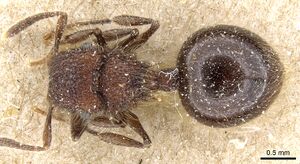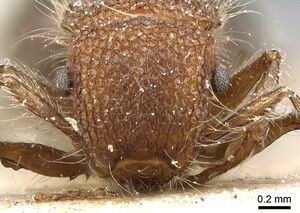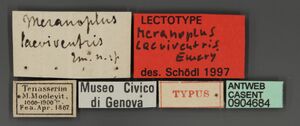Meranoplus laeviventris
| Meranoplus laeviventris | |
|---|---|

| |
| Scientific classification | |
| Kingdom: | Animalia |
| Phylum: | Arthropoda |
| Class: | Insecta |
| Order: | Hymenoptera |
| Family: | Formicidae |
| Subfamily: | Myrmicinae |
| Tribe: | Crematogastrini |
| Genus: | Meranoplus |
| Species: | M. laeviventris |
| Binomial name | |
| Meranoplus laeviventris Emery, 1889 | |
| Synonyms | |
| |
Collected from rainforest in Yunnan Province, China.
Identification
Schödl (1998) – Meranoplus laeviventris is the only Oriental species known from continental Asia to possess a quadrangular petiole in profile. This trait in addition to the dark colour and the shape of the promesonotum makes it distinctive from all its congeners.
Keys including this Species
Distribution
Latitudinal Distribution Pattern
Latitudinal Range: 29.566° to 18.8°.
| North Temperate |
North Subtropical |
Tropical | South Subtropical |
South Temperate |
- Source: AntMaps
Distribution based on Regional Taxon Lists
Oriental Region: India, Laos, Myanmar (type locality), Thailand.
Palaearctic Region: China.
Distribution based on AntMaps
Distribution based on AntWeb specimens
Check data from AntWeb
Countries Occupied
| Number of countries occupied by this species based on AntWiki Regional Taxon Lists. In general, fewer countries occupied indicates a narrower range, while more countries indicates a more widespread species. |

|
Estimated Abundance
| Relative abundance based on number of AntMaps records per species (this species within the purple bar). Fewer records (to the left) indicates a less abundant/encountered species while more records (to the right) indicates more abundant/encountered species. |

|
Biology
Castes
Worker
Images from AntWeb
   
| |
| Lectotype of Meranoplus laeviventris punctulata. Worker. Specimen code casent0904685. Photographer Z. Lieberman, uploaded by California Academy of Sciences. | Owned by MSNG, Genoa, Italy. |
    
| |
| Lectotype of Meranoplus laeviventris. Worker. Specimen code casent0904684. Photographer Z. Lieberman, uploaded by California Academy of Sciences. | Owned by MSNG, Genoa, Italy. |
Nomenclature
The following information is derived from Barry Bolton's Online Catalogue of the Ants of the World.
- laeviventris. Meranoplus laeviventris Emery, 1889b: 506, pl. 10, fig. 16 (w.) MYANMAR.
- Type-material: lectotype worker (by designation of Schödl, 1998: 380), 1 paralectotype worker.
- Type-locality: lectotype Myanmar (“Burma”): Tenasserim, Mt Mooleyit, 1000-1900 m., iv.1887 (L. Fea); paralectotype Myanmar: Tennaserim, Kawkareet, v.1887 (L. Fea).
- Type-depositories: MSNG (lectotype); NHMW (paralectotype).
- [Misspelled as leviventris by Dalla Torre, 1893: 137.]
- Status as species: Emery, 1895k: 472; Forel, 1903a: 705; Bingham, 1903: 170; Emery, 1924d: 228; Chapman & Capco, 1951: 113; Bolton, 1995b: 251; Wu, J. & Wang, 1995: 79; Schödl, 1998: 380 (redescription); Mathew & Tiwari, 2000: 333; Jaitrong & Nabhitabhata, 2005: 27; Guénard & Dunn, 2012: 44; Bharti & Akbar, 2014c: 814 (in key); Bharti, Guénard, et al. 2016: 38; Jaitrong, Guénard, et al. 2016: 36.
- Senior synonym of punctulata: Schödl, 1998: 380.
- Distribution: Laos, Myanmar, Thailand.
- punctulata. Meranoplus laeviventris var. punctulata Emery, 1895k: 472 (w.) MYANMAR.
- Type-material: lectotype worker (by designation of Schödl, 1998: 380), 2 paralectotype workers.
- Type-locality: lectotype Myanmar (“Burma”): Carin Cheba, 900-1100 m., i.1889 (L. Fea); paralectotypes with same data.
- Type-depositories: MSNG (lectotype); MSNG, NHMW (paralectotype).
- Subspecies of laeviventris: Forel, 1903a: 705; Emery, 1924d: 228; Chapman & Capco, 1951: 113; Bolton, 1995b: 251.
- Junior synonym of laeviventris: Schödl, 1998: 380.
Unless otherwise noted the text for the remainder of this section is reported from the publication that includes the original description.
Description
Worker
Schödl (1998) - TL: 4.1 - 4.5, HL: 0.98 - 1.07, HW: 0.95 - 1.05, CI: 93 - 100, SL: 0.75 - 0.8, SI: 73 - 80, PML: 0.6 - 0.8, PW: 0.75 - 0.85, PMI: 134 - 142, AL: 0.95 - 1.17 (15 measured).
Mandibles striate, armed with four teeth. Mid-portion of clypeus shining, concave, laterally with few rugae or wrinkles; anterior clypeal margin produced into a narrow entire apron. Frontal triangle a narrow, brilliant and striate, arcuate furrow between clypeus and frons. Head above antennal scrobes trapezoid, lateral sides evenly narrowed towards clypeus; ventral part of head (below antennal scrobes) wider, more rectangular, the genae thus distinctly protruding and visible from above. Antennal scrobes roughly carinulate, the genae rugulose. Compound eyes situated behind middle of lateral sides of head, not close to posterior corners. Maximum diameter of eye 0.19 - 0.23, with 13-14 ommatidia in its longest row. Dorsum of head anteriorly rugulose, towards occiput reticulate-rugulose, width of meshes ca. 50 - 80 μm.
Promesonotum slightly wider than long, distinctly converging posteriorly, provided with lateral and posterior projections. Margins of promesonotal shield overhanging sides of alitrunk laterally and propodeum posteriorly. Anterior pronotal corners produced into stout teeth followed by the sinuate pronotal margin. A distinct lateral constriction is situated at about the level of (invisible) promesonotal suture. At the same level a translucent fenestra on each side of the lateral margin is apparent. Posteriorly, the lateral margins of the mesonotum are provided with a blunt, massive projection on each side. Posterior mesonotal corners produced into short spines, directed ca. 45 from the shield, and on the posterior margin the mesonotum with a pair of paramedian straight, short spines. Declivity of propodeum brilliant throughout, with a very faint shagreening and occasional transverse or longitudinal rugae which especially are found beneath the posterior mesonotal margin between the propodeal spines. Long, considerably diverging propodeal spines situated high on the lateral sides of propodeum, distinctly above middle; when viewed in profile slightly arcuate. No suture between dorsal alitrunk and propodeum is apparent on the declivity when viewed from behind. Dorsum of promesonotum reticulate-rugulose, the meshes of about same size or slightly wider than those on head (ca. 50 - 80(100) μm). Petiole distinctly truncate, in lateral and dorsal view quadrangular. Anterior face of petiole without structure, the dorsum, sides and posterior face roughly rugulose, the posterior declivity near base somewhat more costulate. Postpetiole nodiform, reticulate throughout, width of meshes ca. 30 - 50 μm. First gastral tergite glabrous, occasionally with inconspicuous shagreening, especially anteriorly and around hair-pits ("punctulatus"). Pubescence of entire dorsum consisting of thin, whitish, moderately long hairs (ca. 200 - 300 μm) and few outstanding, distinctly longer (-400 μm) ones. Colour of a dark brown to piceous black, frequently the head, alitrunk, petiole and appendages somewhat brighter.
Type Material
Schödl (1998) - Lectotype worker (Museo Civico di Storia Naturale, Genoa), by present designation: "Tenasserim M. Mooleyit, 1000-1900 m. Fea. Apr. 1887 \ TYPUS \ Meranoplus laeviventris Em. n. sp \ Museo Civico di Geneva". 1 paralectotype worker. "Tenasserim. Kawkareet Fea. Maggio 1887. \ Meranoplus laeviventris Em \ Collect. G.Mayr \ laeviventris Emery, Type." in Naturhistorisches Museum Wien, Vienna. Type locality: Tenasserim, Kawkareet, Myanmar.
References
- Emery, C. 1889c. Formiche di Birmania e del Tenasserim raccolte da Leonardo Fea (1885-87). [part]. Ann. Mus. Civ. Stor. Nat. 27[=(2)(7): 485-512 (page 506, pl. 10, fig. 16 worker described)
- Khachonpisitsak, S., Yamane, S., Sriwichai, P., Jaitrong, W. 2020. An updated checklist of the ants of Thailand (Hymenoptera, Formicidae). ZooKeys 998, 1–182 (doi:10.3897/zookeys.998.54902).
- Liu, C., Fischer, G., Hita Garcia, F., Yamane, S., Liu, Q., Peng, Y.Q., Economo, E.P., Guénard, B., Pierce, N.E. 2020. Ants of the Hengduan Mountains: a new altitudinal survey and updated checklist for Yunnan Province highlight an understudied insect biodiversity hotspot. ZooKeys 978, 1–171 (doi:10.3897/zookeys.978.55767).
- Schödl, S. 1998. Taxonomic revision of Oriental Meranoplus F. Smith, 1853 (Insecta: Hymenoptera: Formicidae: Myrmicinae). Ann. Naturhist. Mus. Wien. B. Bot. Zool. 100: 361-394 (page 380, Senior synonym of punctulata)
- Yodprasit, K., Buddhakala, N., Tasen, W., Jaitrong, W. 2024. Two new species and a new record of the ant genus Meranoplus Smith, 1853 (Hymenoptera, Formicidae, Myrmicinae) from Thailand. ZooKeys 1210, 207–227 (doi:10.3897/zookeys.1210.125990).
References based on Global Ant Biodiversity Informatics
- Chapman, J. W., and Capco, S. R. 1951. Check list of the ants (Hymenoptera: Formicidae) of Asia. Monogr. Inst. Sci. Technol. Manila 1: 1-327
- Chen Y. Q., Q. Li, Y. L. Chen, Z. X. Lu, X. Y. Zhou. 2011. Ant diversity and bio-indicators in land management of lac insect agroecosystem in Southwestern China. Biodivers. Conserv. 20: 3017-3038.
- Fontanilla A. M., A. Nakamura, Z. Xu, M. Cao, R. L. Kitching, Y. Tang, and C. J. Burwell. 2019. Taxonomic and functional ant diversity along tropical, subtropical, and subalpine elevational transects in southwest China. Insects 10, 128; doi:10.3390/insects10050128
- Guénard B., and R. R. Dunn. 2012. A checklist of the ants of China. Zootaxa 3558: 1-77.
- Huang Jian-hua, Zhou Shan-yi. 2007. A checklist of family Formicidae of China - Myrmicinae (Part II) (Insecta: Hymenoptera). Journal of Guangxi Normal University : Natural Science Edition 25(1): 91-99.
- Jaitrong W., B. Guenard, E. P. Economo, N. Buddhakala, and S. Yamane. 2016. A checklist of known ant species of Laos (Hymenoptera: Formicidae). Asian Myrmecology 8: 1-32. DOI: 10.20362/am.008019
- Jaitrong W.; Nabhitabhata, J. 2005. A list of known ant species of Thailand. The Thailand Natural History Museum Journal 1(1): 9-54.
- Li Z.h. 2006. List of Chinese Insects. Volume 4. Sun Yat-sen University Press
- Liu X. 2012. Taxonomy, diversity and spatial distribution characters of the ant family Formicidae (Insecta: Hymenoptera) in southeastern Tibet. PhD Thesis 139 pages
- Liu X., Z. Xu, N. Yu, and C. Zhang. 2016. Distribution patterns of ant species ( Hymenoptera: Formicidae) in Galongla Mountains and Medog Valley of Southeastern Tibet. Scientia Silvae Sinicae 52(11): 88-95.
- Lu Z., B. D. Hoffmann, and Y. Chen. 2016. Can reforested and plantation habitats effectively conserve SW China’s ant biodiversity? Biodivers. Conserv. DOI 10.1007/s10531-016-1090-1
- Lu Z., K. Li, N. Zhang, and Y. Chen. 2017. Diversity and indicator species of leaf-litter ants in Eucalyptus grandis plantations and secondary natural forests. Forest Research 29(4): 576-580
- Mathew R. 2003. On Formicidae (Insecta: Hymenoptera) of Nongkhyllem Wild Life Sanctuary, Ri-Bhoi District, Meghalaya. Records of the Zoological Survey of India 101:195-207.
- Mathew R., and R. N. Tiwari. 2000. Insecta: Hymenoptera: Formicidae. Pp. 251-409 in: Director; Zoological Survey of India (ed.) 2000. Fauna of of Meghalaya. Part 7. [State Fauna Series 4.] Insecta 2000. Calcutta: Zoological Survey of India, 621 pp.
- Schödl S. 1998. Taxonomic revision of Oriental Meranoplus F. Smith, 1853 (Insecta: Hymenoptera: Formicidae: Myrmicinae). Annalen des Naturhistorischen Museums in Wien. B, Botanik, Zoologie 100: 361-394.
- Xu Z. H., B. L. Yang, and G. Hu. 1999. Formicidae ant communities in fragments of montane rain forest in Xishuangbanna, China. Zoological Research 20(4): 288-293.
- Xu Z. 1999. [An analysis on the ant fauna of the tropical rain forest in Xishuangbanna of China.] Zoological Research 20: 379-384.
- Zhang N. N., Y. Q. Chen, Z. X. Lu, W. Zhang, and K. L. Li. 2013. Species diversity, community structure difference and indicator species of leaf-litter ants in rubber plantations and secondary natural forests in Yunnan, southwestern China. Acta Entomologica Sinica 56(11): 1314-1323.


